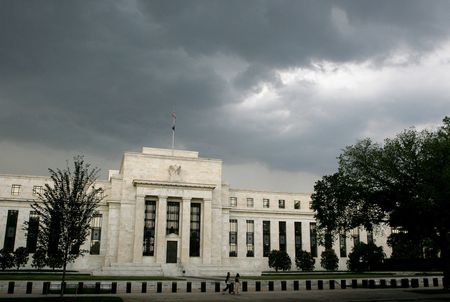By Ann Saphir and Lindsay Dunsmuir
(Reuters) -U.S. central bankers are looking through recent data showing price pressures rebounded last month, and are focusing instead on overall progress on inflation that they say will likely set the table for interest-rate cuts later this year.
“I expect things are going to be bumpy,” Atlanta Federal Reserve Bank President Raphael Bostic said during an interview at a banking conference in Atlanta, Georgia, after a Commerce Department report showed the core personal consumption expenditures price index rose more than 5% on an annualized basis, sharply higher than the previous several months of readings.
But compared with a year ago, the measure of underlying inflation ticked down, to 2.8% from 2.9% in December; six-month and three-month annualized inflation rates are even closer to the Fed’s 2% target.
Bostic said his eye remains on the longer-term trends and repeated his view that he sees the U.S. central bank beginning to cut rates “in the summer time,” if the economy evolves as he expects.
Fed policymakers have kept the policy rate in the 5.25%-5.5% range since July, and in December policymakers as a group anticipated they would likely end up cutting rates to the 4.5%-4.75% range by the end of 2024.
Cleveland Fed President Loretta Mester, speaking with Yahoo! Finance later in the day, said three rate cuts is still her baseline view.
“Right now, that feels about right to me if the economy evolves as I anticipate it will,” she said, adding that she, like her fellow policymakers, will pencil in fresh economic forecasts when they next meet, in about three weeks.
Mester said she expects employment and wage growth to cool in coming months, easing price pressures and giving her more assurance that inflation is headed sustainably back to the Fed’s goal.
Chicago Federal Reserve Bank President Austan Goolsbee, like Mester and Bostic, also shrugged off January’s inflation data as indicative of a setback, and said he believes the disinflationary effect of last year’s supply chain improvements and immigration-fueled rise in labor supply have a “decent chance” of continuing into this year.
And that, he said, means there is still scope for the U.S. economy this year to continue on what he has dubbed the “golden path” of falling inflation alongside a robust labor market and economic growth, a historically unusual pattern.
“Rates are pretty restrictive,” Goolsbee said in an event sponsored by Princeton University. “The question is, how long to remain this restrictive.”
If inflation continues to come down, he said, the Fed’s policy rate will become increasingly restrictive in “real” terms even if it is held steady.
“Eventually,” he added, that could hurt the labor market.
U.S. unemployment, at 3.7%, is only a few tenths of a percentage point above where it was when the Fed began its rate-hike campaign in March 2022.
(Reporting by Ann Saphir with reporting by Khushi Singh and Howard Schneider; Editing by Toby Chopra, Chizu Nomiyama and Diane Craft)










